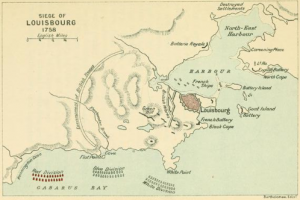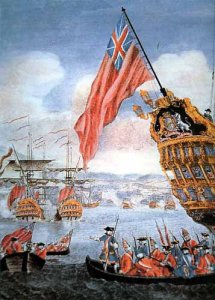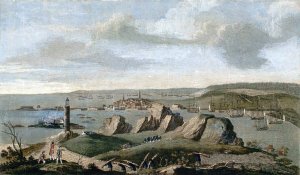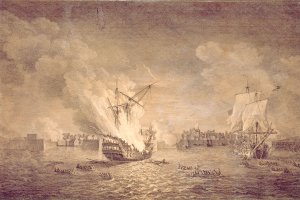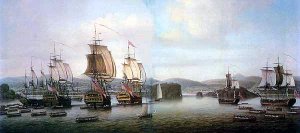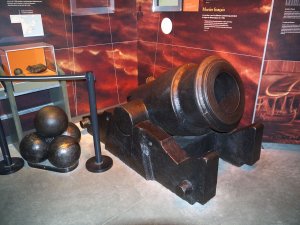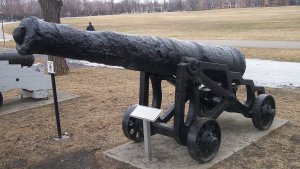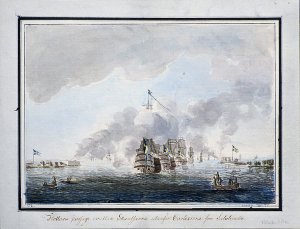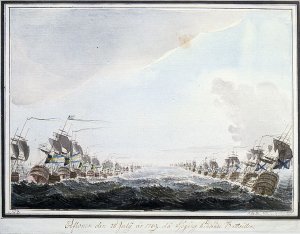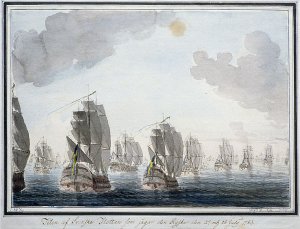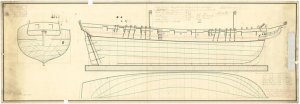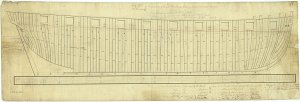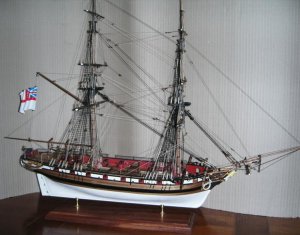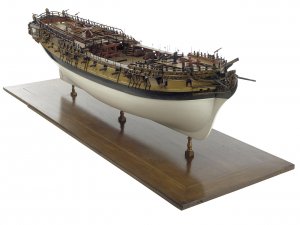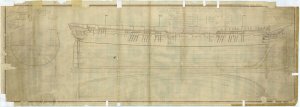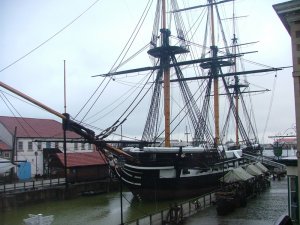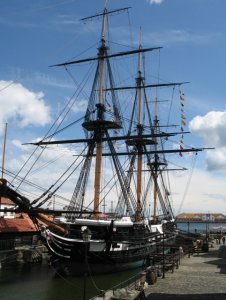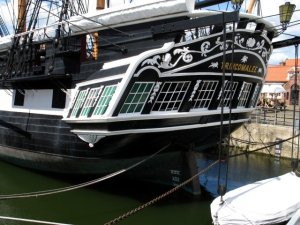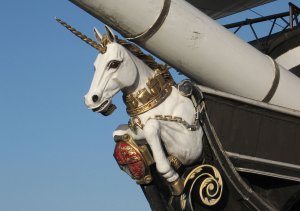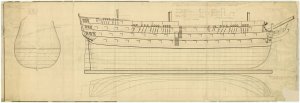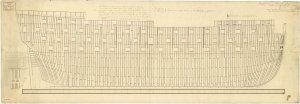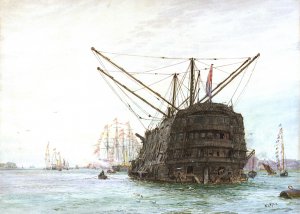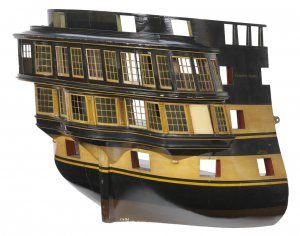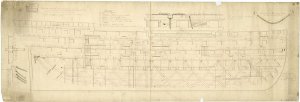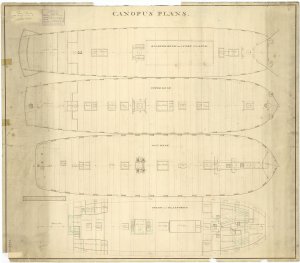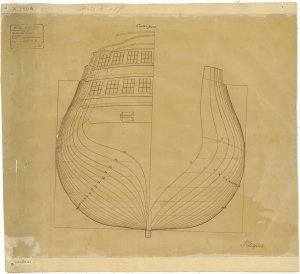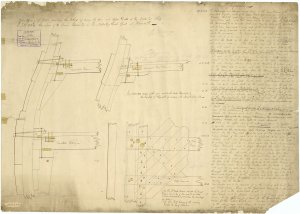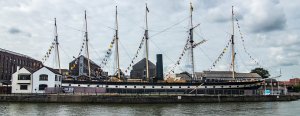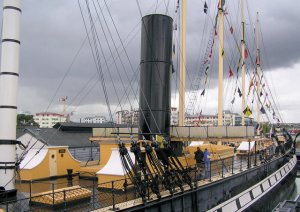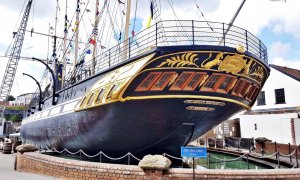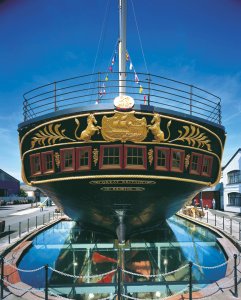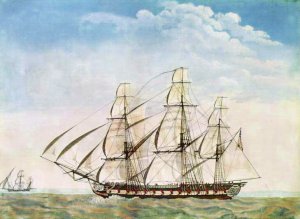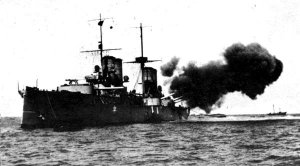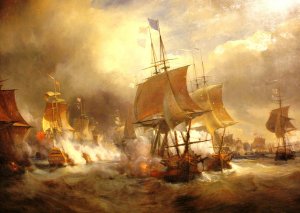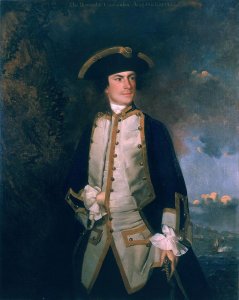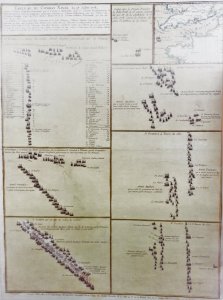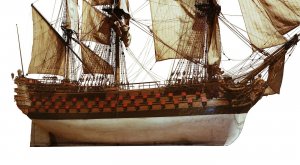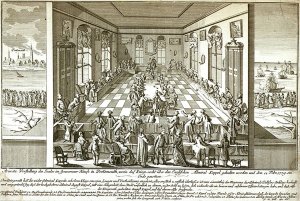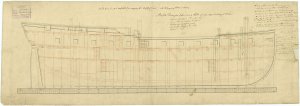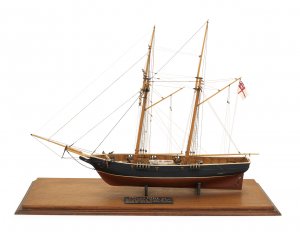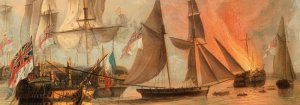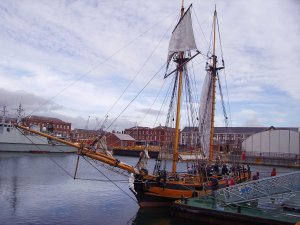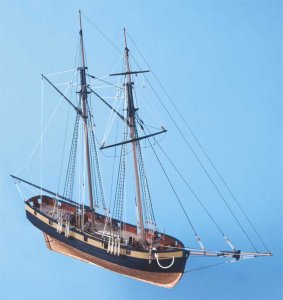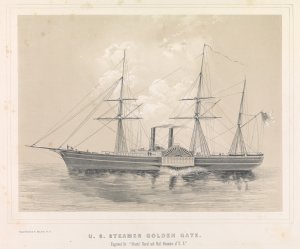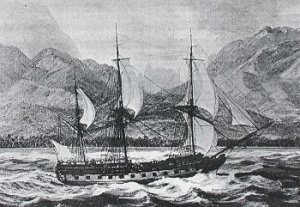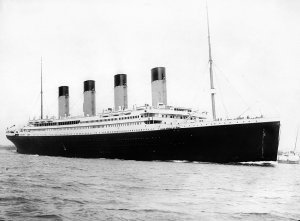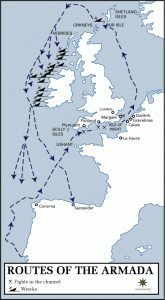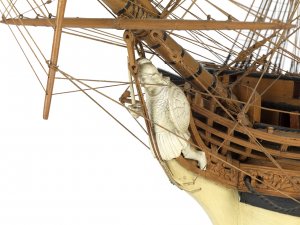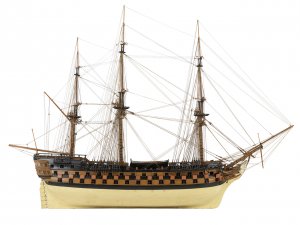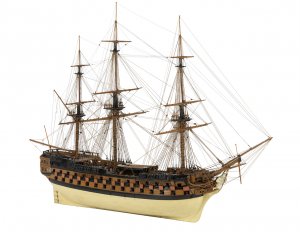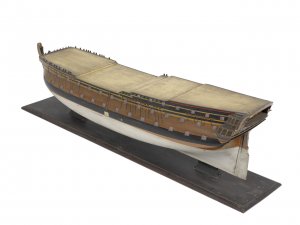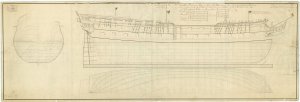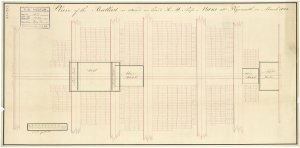Other events on 25 July
1278 - The naval Battle of Algeciras takes place in the context of the Spanish Reconquista resulting in a victory for the Emirate of Granada and the Maranid Dynasty over the Kingdom of Castile.
https://en.wikipedia.org/wiki/Battle_of_Algeciras_(1278)
1757 - HMS Southampton (32), Cptn. James Gilchrist, engaged five French privateers off the Isle of Wight
1779 - US Amphibious expedition against British in Penobscot Bay, ME
1800 - HMS Nemesis (28), Cptn. Thomas Baker, and HMS Arrow (28), William Bolton, captured Danish frigate Freya (40), Cptn. Krabbe.
1803 HMS Vanguard (1787) (74), Cptn. James Walker, and HMS Tartar (32), Cptn. Perkins, captured Duquesne (74) off San Domingo
On 24 July, two French 74s, Duquesne and Duguay Trouin, and the frigate Guerrière put to sea from Cap-Français during a squall in an effort to evade Bellerophon, Elephant, Theseus, Tartar under Captain Perkins, and Vanguard, which were blockading the port. The French ships separated during the night but the British overtook Duquesne the following day and captured her after a short exchange of fire with Vanguard, which lost one man killed and one wounded. The prize was broken up on arrival in England after being damaged running on to the Morant Cays.

https://en.wikipedia.org/wiki/HMS_Vanguard_(1787)
1809 - HMS Princess Caroline (74), Cptn. Charles Dudley Pater, and consorts captured four Russian vessels.
HMS Princess Carolina (1807) was a 74-gun third rate, also known as Princess Caroline. She was previously the Danish ship Prindsesse Carolina, but was captured at the Battle of Copenhagen in 1807. There were plans to rename her HMS Braganza, but this was never carried out and she was sold in 1815.

Scale: 1:48. Plan showing the body plan, stern board outline, sheer lines with inboard detail and scroll figurehead, and longitudinal half-breadth for 'Princess Caroline' (captured 1807), a captured Danish Third Rate, as fitted for a 74-gun Third Rate, two-decker at Portsmouth Dockyard in 1808. Signed by Henry Canham [Assistant to Master Shipwright, Portsmouth Dockyard 1801-1813].
Read more at http://collections.rmg.co.uk/collections/objects/80969.html#0e4qKq0o8wMZik8H.99
1809 - Boats of HMS Fawn (18) captured Guadaloupe.
1810 - HMS Thames (32), Cptn. Granville George Waldegrave, HMS Pilot (18), John Toup Nicholas, and HMS Weazle (18), Henry Prescott, at Amanthe. Six gunboats, two scampavias and 28 transports were taken and the rest of a convoy destroyed.
1863 - U.S. Squadron bombards Fort Wagner, NC
1839 - Birth of Francis Garnier

Marie Joseph François Garnier (Vietnamese: Ngạc Nhi; 25 July 1839 – 21 December 1873) was a French officer, inspector of Indigenous Affairs of Cochinchina and explorer. He eventually became mission leader of the Mekong Exploration Commission in 19th century Southeast Asia.
https://en.wikipedia.org/wiki/Francis_Garnier
1898 - During the Spanish-American War, a landing party from the armed yacht, USS Gloucester, single-handedly captures Guanica, Puerto Rico.
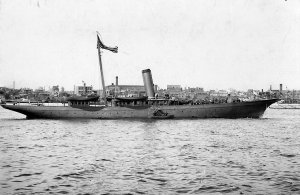
On 25 July, she entered the harbor before the fleet at Guánica, Puerto Rico, and captured the place for the U.S. Army in what is known as the Puerto Rican Campaign. The handling and fighting of Gloucester merited the commendation of the Navy Department. As the Army was anxious to transfer the place of disembarkation to the harbor of Ponce, the Fleet was directed to proceed to Ponce to reconnoiter; capture all lighters found there; and occupy such positions necessary for holding the port until the arrival of the Army. On 1 August, with assistance from Wasp, Gloucester took possession of Arroyo, and hoisting the U.S. flag, Wainwright held it until arrival of the Army, a day later.
https://en.wikipedia.org/wiki/USS_Gloucester_(1891)
1943 - The first Navy ship named for an African-American, USS Harmon (DE 678), is launched. USS Harmon is named in honor of Mess Attendant 1st Class Leonard Roy Harmon who posthumously receives the Navy Cross for heroic actions trying to save a shipmate on board USS San Francisco (CA 38) during the Naval Battle of Guadalcanal on Nov. 13, 1942.
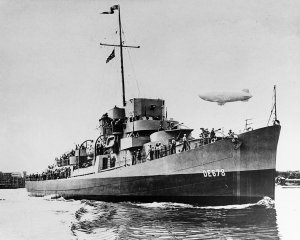
https://en.wikipedia.org/wiki/USS_Harmon_(DE-678)
1946 - The second of two nuclear weapon tests - BAKER - is detonated during Operation Crossroads at Bikini Atoll, Marshall Islands. The first test was ABLE.

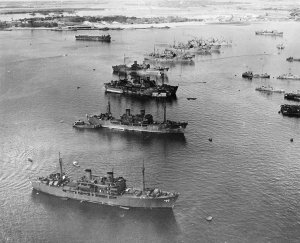
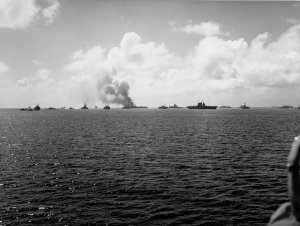
https://en.wikipedia.org/wiki/Operation_Crossroads
1278 - The naval Battle of Algeciras takes place in the context of the Spanish Reconquista resulting in a victory for the Emirate of Granada and the Maranid Dynasty over the Kingdom of Castile.
https://en.wikipedia.org/wiki/Battle_of_Algeciras_(1278)
1757 - HMS Southampton (32), Cptn. James Gilchrist, engaged five French privateers off the Isle of Wight
1779 - US Amphibious expedition against British in Penobscot Bay, ME
1800 - HMS Nemesis (28), Cptn. Thomas Baker, and HMS Arrow (28), William Bolton, captured Danish frigate Freya (40), Cptn. Krabbe.
1803 HMS Vanguard (1787) (74), Cptn. James Walker, and HMS Tartar (32), Cptn. Perkins, captured Duquesne (74) off San Domingo
On 24 July, two French 74s, Duquesne and Duguay Trouin, and the frigate Guerrière put to sea from Cap-Français during a squall in an effort to evade Bellerophon, Elephant, Theseus, Tartar under Captain Perkins, and Vanguard, which were blockading the port. The French ships separated during the night but the British overtook Duquesne the following day and captured her after a short exchange of fire with Vanguard, which lost one man killed and one wounded. The prize was broken up on arrival in England after being damaged running on to the Morant Cays.

https://en.wikipedia.org/wiki/HMS_Vanguard_(1787)
1809 - HMS Princess Caroline (74), Cptn. Charles Dudley Pater, and consorts captured four Russian vessels.
HMS Princess Carolina (1807) was a 74-gun third rate, also known as Princess Caroline. She was previously the Danish ship Prindsesse Carolina, but was captured at the Battle of Copenhagen in 1807. There were plans to rename her HMS Braganza, but this was never carried out and she was sold in 1815.

Scale: 1:48. Plan showing the body plan, stern board outline, sheer lines with inboard detail and scroll figurehead, and longitudinal half-breadth for 'Princess Caroline' (captured 1807), a captured Danish Third Rate, as fitted for a 74-gun Third Rate, two-decker at Portsmouth Dockyard in 1808. Signed by Henry Canham [Assistant to Master Shipwright, Portsmouth Dockyard 1801-1813].
Read more at http://collections.rmg.co.uk/collections/objects/80969.html#0e4qKq0o8wMZik8H.99
1809 - Boats of HMS Fawn (18) captured Guadaloupe.
1810 - HMS Thames (32), Cptn. Granville George Waldegrave, HMS Pilot (18), John Toup Nicholas, and HMS Weazle (18), Henry Prescott, at Amanthe. Six gunboats, two scampavias and 28 transports were taken and the rest of a convoy destroyed.
1863 - U.S. Squadron bombards Fort Wagner, NC
1839 - Birth of Francis Garnier

Marie Joseph François Garnier (Vietnamese: Ngạc Nhi; 25 July 1839 – 21 December 1873) was a French officer, inspector of Indigenous Affairs of Cochinchina and explorer. He eventually became mission leader of the Mekong Exploration Commission in 19th century Southeast Asia.
https://en.wikipedia.org/wiki/Francis_Garnier
1898 - During the Spanish-American War, a landing party from the armed yacht, USS Gloucester, single-handedly captures Guanica, Puerto Rico.

On 25 July, she entered the harbor before the fleet at Guánica, Puerto Rico, and captured the place for the U.S. Army in what is known as the Puerto Rican Campaign. The handling and fighting of Gloucester merited the commendation of the Navy Department. As the Army was anxious to transfer the place of disembarkation to the harbor of Ponce, the Fleet was directed to proceed to Ponce to reconnoiter; capture all lighters found there; and occupy such positions necessary for holding the port until the arrival of the Army. On 1 August, with assistance from Wasp, Gloucester took possession of Arroyo, and hoisting the U.S. flag, Wainwright held it until arrival of the Army, a day later.
https://en.wikipedia.org/wiki/USS_Gloucester_(1891)
1943 - The first Navy ship named for an African-American, USS Harmon (DE 678), is launched. USS Harmon is named in honor of Mess Attendant 1st Class Leonard Roy Harmon who posthumously receives the Navy Cross for heroic actions trying to save a shipmate on board USS San Francisco (CA 38) during the Naval Battle of Guadalcanal on Nov. 13, 1942.

https://en.wikipedia.org/wiki/USS_Harmon_(DE-678)
1946 - The second of two nuclear weapon tests - BAKER - is detonated during Operation Crossroads at Bikini Atoll, Marshall Islands. The first test was ABLE.



https://en.wikipedia.org/wiki/Operation_Crossroads




